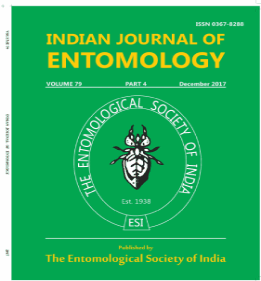Pollinators in Tropical Ecosystems of Southern India with Emphasis on the Native Pollinators Apis cerana indica and Tetragonula iridipennis
DOI:
https://doi.org/10.55446/IJE.2021.369Keywords:
Hymenoptera, Apidae, pollinators, agroecosystems, pollinator decline, pollen, melissopalynology, transformation, landscapes, pollination service, management of honey bees, conservationAbstract
Ecosystems are rapidly urbanizing at the global and regional scales, particularly in the tropics, which has deleterious effect on hymenopteran pollinators. Based on the literature spanning multiple disciplines including ecology, pollination, agriculture, agroecology and entomology, this review deliberates on the pollinators and their global decline. Also, it turns the focus on honey bees and their role in agroecosystem. Relevant information from melissopalynology is brought together and the gaps and directions of future research on conservation and management of honey bees in tropical peninsular India are discussed. Focus is on the two species of the hived native Apis cerana indica F., and Tetragonula iridipennis Smith (Hymenoptera: Apidae), as these play a major role in transforming existing agricultural landscapes into agroecosystems, benefitting the farmers and maintaining ecological balance in tropical peninsular India. This review brings to the fore the fact that there is a tangible gap in reports and long-term studies of many native pollinators and in particular the two hived honey bees. Most studies present in a thorough manner visual observations of pollinators (bees) on plants but rarely combine them with quantifying the resources gathered from the plants, especially pollen. This combined approach is especially important to understand the hymenopteran pollinators from the purview of the pollination service they provide. It can be concluded that there is a pressing requirement for long-term observations along these lines with quantifiable pollen and vegetation data to arrive at meaningful plant-pollinator networks that are essential for conservation and management of the native Asiatic honey bees as pollinators.
Downloads
Metrics
Downloads
Published
How to Cite
Issue
Section
References
Abrol D P. 2011. Foraging. pp 257-292. Hepburn H, Radloff S (eds.) Honey bees of Asia. Springer, Berlin, Heidelberg. https://doi.org/10.1007/978-3-642-16422-4_12. 668 pp.
Abrol D P. 2012. Pollination Biology, Springer, Dordrecht. https://doi.org/10.1007/978-94-007-1942-2_15. 792 pp.
Agashe S N, Mary Scinthia J D. 1995. Pollen spectrum of pollen loads collected from Thally Block, Dharampuri district, Tamilnadu. Journal of Palynology 31: 207-212.
Allen-Wardell G, Bernhardt P, Bitner R, Burquez A, Buchmann S, Cane J, ... Walker S. 1998. The potential consequences of pollinator declines on the conservation of biodiversity and stability of food crop yields. Conservation Biology 8-17.
Anonymous. 2020. Available from: https://theindianblog.in/top-10-states-india/top-10-vegetable-producing-states-in-india/ (date of access: 23 September 2021).
Baskaran M, Thiyagesan K. 2013. Biometric studies of the Indian honey bee Apis cerana indica (Fabr.) in the Nagapattinam District, Tamil Nadu, Southern India. Journal of Apicultural Research 52(2): 15-23.
Basu P, Bhattacharya R, Ianetta P. 2011. A decline in pollinator dependent vegetable crop productivity in India indicates pollination limitation and consequent agro-economic crises. Nature Precedings 1-1.
Batista M A, Ramalho M, Soares A E. 2003. Nesting sites and abundance of Meliponini (Hymenoptera: Apidae) in heterogeneous habitats of the Atlantic Rain Forest, Bahia, Brazil. Lundiana: International Journal of Biodiversity 4(1): 19-23.
Bhalchandra W, Baviskar R K, Nikam T B. 2014. Diversity of nectariferous and polleniferous bee flora at Anjaneri and Dugarwadi hills of Western Ghats of Nasik district (MS) India. Journal of Entomology and Zoology Studies 2(4): 244-249.
Bhattacharyya M, Acharya S K, Chakraborty S K. 2017. Pollinators unknown: People’s perception of native bees in an agrarian district of West Bengal, India, and its implication in conservation. Tropical Conservation Science10: 1-14.
Biesmeijer J C, Roberts S P, Reemer M, Ohlemüller R, Edwards M, Peeters T, Kunin W E. 2006. Parallel declines in pollinators and insect-pollinated plants in Britain and the Netherlands. Science 313: 351-354.
Bisui S, Layek U, Karmakar P. 2019. Comparing the pollen forage pattern of stingless bee (Trigona iridipennis Smith) between rural and semi-urban areas of West Bengal, India. Journal of Asia-Pacific Entomology 22(3): 714-722.
Borges R M, Gowda V, Zacharias M. 2003. Butterfly pollination and high-contrast visual signals in a low-density distylous plant. Oecologia 136(4): 571-573.
Borges R M, Somanathan H, Kelber A. 2016. Patterns and processes in nocturnal and crepuscular pollination services. The Quarterly review of biology 91(4): 389-418.
Camargo J M F, Moure J S, Roubik D W. 1988. Melipona yucatanica new species (Hymenoptera: Apidae; Meliponinae); stingless bee dispersal across the Caribbean arc and Post-Eocene vicariance, Pan-Pacific Entomologist. 64: 147-157.
Carvell C, Meek W R, Pywell R F, Goulson, D, Nowakowski M. 2007. Comparing the efficacy of agri-environment schemes to enhance bumble bee abundance and diversity on arable field margins. Journal of Applied Ecology 44(1): 29-40.
Chakraborti T, Bhattacharya K. 2015. Melissopalynological studies in India: A review. Annals of plant sciences 4(11):1217-1222.
Chalapathy C V, Puttaraju H P, Sivaram V. 2014. A pilot study on genetic diversity in Indian honey bees-Apiscerana of Karnataka populations. Journal of Entomology and Zoology Studies 2(3): 7-13.
Chaudhary O P. 2001. Bee forage and floral calendar of India. pp 61-65.Recent advances in Apiculture.Yadav P R (ed.), CCS Haryana Agricultural University, Hisar.
Clarke D A, Palmer D J, McGrannachan C, Burgess T I, Chown S L, Clarke R H, Kumschick S, Lach L, Liebhold A M, Roy H E, Saunders M E, Yeates D K, Zalucki M P, McGeoch M A. 2021. Options for reducing uncertainty in impact classification for alien species. Ecosphere 12(4): e03461.
Corlett R T. 2011. Honey bees in Natural Ecosystems. pp. 215-226. Hepburn H R, Radloff S E (eds.). Honey bees of Asia, Springer, Berlin, Heidelberg, Germany. 669 pp.
Danaraddi C S, Shashidhar V, Basavanagoud K, Bhat A R S. 2009. Nesting habits and nest structure of stingless bee, Trigona iridipennis Smith at Dharwad, Karnataka. Karnataka Journal of Agricultural Sciences 22(2): 310-313.
Darwin C. 1876.The Effects of Cross and Self Fertilisation in the Vegetable Kingdom. John Murray, Albemarle Street. 621 pp.
Deodikar G B, Suryanarayana M C. 1973. Bees enhance crop yields. Indian Farming 23: 31-36.
Deodikar G B. 1960. Some indications on the phylogenetic interrelations among bees. Bee Genetic Information Bulletin: 15-16.
Dhaliwali H S, Sharma P L. 1974. Foraging range of the Indian honey bee. Journal of Apicultural Research 13(2): 137-141.
Dicks LV, Breeze T D, Ngo H T, Senapathi D, An J, Aizen M A, Basu P, Buchori D, Galetto L, Garibaldi L A, Gemmill-Herren B….Vanbergen A J, Potts S G. 2021. A global-scale expert assessment of drivers and risks associated with pollinator decline. Nature Ecology & Evolution. https://doi.org/10.1038/s41559-021-01534-9 (date of access: 23 September 2021).
Dulta P C, Verma L R. 1987. Role of insect pollinators on yield and quality of apple fruit.Indian journal of Horticulture 44(3, 4): 274-279.
Fatima K, Ramanujam C G K. 1989. Pollen analysis of two multifloral honeys from Hyderabad, Andhra Pradesh. Journal of Phytology Research. 2:167-172.
Fitch G, Wilson C J, Glaum P, Vaidya C, Simao M C, Jamieson M A. 2019. Does urbanization favour exotic bee species? Implications for the conservation of native bees in cities. Biology letters 15(12): 20190574.
Garg A, Nair P. 1993. Honey bee pollen loads as a bio-indicator of bee pasturage in Bhimtal area of Western Himalayas, India. Journal of Palynology 29: 89-107.
Garg A. 1996. Palynocontents of bee-collected pollen loads of autumn season in Bhimal, India. Taiwania 41(3): 197-207.
Grüter C. 2020. Stingless Bees, Their Behaviour, Ecology and Evolution. Cham, Switzerland: Springer International Publishing. 394 pp.
Goulson D. 2003. Effects of introduced bees on native ecosystems. Annual Review of Ecology, Evolution and Systematics 34(1): 1-26.
Gowda G, Eswarappa G, Vazhacharickal P J. 2020. Bio-ecology of Stingless bees, Trigona iridipennis Smith. (Hymenoptera: Apidae) in GKVK campus: an overview. 161 pp.
Goyal N P. 1990. Introduction of Apis mellifera in India: background and present status. Indian Bee Journal 52(1-4): 57-59.
Guerin E. 2020. Native Honey Bees of Southeast Asia and Conservation Challenges. Available from: https://th.boell.org/en/2020/02/13/native-honey-bees-southeast-asia-and-conservation-challenges (date of access: 23 September 2021).
Gupta J K, Mishra R C, Kumar J. 1984. Plectranthus as forage for Apis cerana indica F. and Apis mellifera L. Apidologie 15(1): 75-82.
Hallmann C A, Sorg M, Jongejans E, Siepel H, Hofland N, Schwan H, Stenmans W., Müller A, Sumser H, Hörren T, Goulson D. 2017. More than 75 percent decline over 27 years in total flying insect biomass in protected areas. PloS one 12(10): p.e0185809.
Hemalatha D, Jayaraj J, Murugan M, Balamohan T N, Senthil N, Chinniah C, Suresh K. 2018. Floral diversity for foraging of the Asiatic honey bee, Apis cerana indica (Hymenoptera: Apidae) in Madurai District of Tamil Nadu, India. International journal of current microbiology and applied sciences. 7(10): 3452-3456.
Janzen D H. 1971. Euglossine bees as long-distance pollinators of tropical plants. Science171: 203-205.
Jay S C. 1974. Seasonal development of honey bee colonies started from package bees. Journal of Apicultural Research 13(2): 149-152.
Jhansi P, Kalpana T P, Ramanujam C G K. 1994. Pollen analysis of some Apis cerana Fab. Honeys from Andhra Pradesh, India. Apidologie 25: 289-296.
Jones G D. 2014. Pollen analyses for pollination research, Acetolysis. Journal of Pollination Ecology13 (21): 203-217.
Kemp J E, Vallejo Marín M. 2021. Pollen dispensing schedules in buzz pollinated plants: experimental comparison of species with contrasting floral morphologies. American Journal of Botany 108(6): 993-1005.
Kevan P G, Clark E A, Thomas V G. 1990. Insect pollinators and sustainable agriculture.American Journal of Alternative Agriculture 5(1): 13-22.
Klein A M, Vaissiere B E, Cane J H, Steffan-Dewenter I, Cunningham S A, KremenC, Tscharntke T. 2007. Importance of pollinators in changing landscapes for world crops. Proceedings of the Royal Society, B: Biological Sciences 274(1608): 303-313.
Koetz A H. 2013. Ecology, behaviour and control of Apis cerana with a focus on relevance to the Australian incursion. Insects 4(4): 558-592.
Kumar H, Srinivas Reddy K M, Shishira D, Eswarappa G. 2020. Role of Apis cerana Fabricius in sunflower pollination. Journal of Entomology and Zoology Studies 8(5): 648-654.
Layek U, Karmakar P. 2018. Nesting characteristics, floral resources, and foraging activity of Trigona iridipennis Smith in Bankura district of West Bengal, India. Insectes sociaux 65: 117–132.
Loose J L, Drummond F A, Stubbs C, Woods S, Hoffman S. 2005. Conservation and management of native bees in cranberry. The University of Maine, Orono 27 pp.
Lunau K, Fieselmann G, Heuschen B, van de Loo A. 2006. Visual targeting of components of floral colour patterns in flower-naive bumblebees (Bombus terrestris; Apidae). Naturwissenschaften 93(7): 325-328.
Mahale M B. 2019. Potential of weeds/wild plants as bee flora with relation to agriculture and forestry. International Journal of Research and Analytical Reviews 6(2): 665-670.
Maeterlinck M. 1901. The life of the bee. Translated by Alfred Sutro Dodd, Mead and Company New York 427 pp.
Mukherjee R, Deb R, Devy S M. 2019. Diversity matters: Effects of density compensation in pollination service during rainfall shift. Ecology and evolution, 9(17): 9701-9711.
Nandhini E, Padmini K, Venugopalan R, Anjanappa M, Lingaiah H B. 2018. Flower-visiting insect pollinators of okra [Abelmoschus esculentus (L.) Moench] in Bengaluru region. Journal of Pharmacognosy and Phytochemistry 7(2): 1406-1408.
Navya R, Krishnakumar C, Balachandran N, Aravajy S, Anupama K. 2017. Resilience of the tropical dry evergreen forest in the human-impacted region of Coromandel Coast, India. Journal of Economic and Taxonomic Botany 41 (1-2): 31-46.
Nicholls C I, Altieri M A. 2013. Plant biodiversity enhances bees and other insect pollinators in agroecosystems. A review. Agronomy for sustainable development. 33: 257–274. https://doi.org/10.1007/s13593-012-0092-y (date of access: 01 February 2022).
Ollerton J. 2015. How good is the evidence base for pollinator declines ? A Comment on the recent Ghazoul and Goulson science correspondence: https://jeffollerton.co.uk/2015/06/03/how-good-is-the-evidence-base-for-pollinator-declines-a-comment-on-the-recent-ghazoul-and-goulson-science-correspondence/ (date of access: 10 January 2022).
Pannure A. 2016. Bee pollinators decline: Perspectives from India. International Research Journal of Natural and Applied Sciences 3(5): 2349-4077.
Ponnuchamy R, Bonhomme V, Prasad S, Das L, Patel P, Gaucherel C, Pragasam A, Anupama K. 2014. Honey pollen: using melissopalynology to understand foraging preferences of bees in tropical South India. PLoS One 9(7): e101618.
Ponnuchamy R. 2014. Melissopalynological and Floristic studies to Understand feeding preferences of two native Honey bees in a restored landscape near Puducherry, South India. PhD thesis (unpublished), Pondicherry University.
Potts S G, Biesmeijer J C, Kremen C, Neumann P, Schweiger O, Kunin, W E. 2010. Global pollinator declines: trends, impacts and drivers. Trends in Ecology & Evolution 25(6): 345-353.
Ramachandran S. 1939. Beekeeping in South India (Revised 3rd Edition). Department of Agriculture, Madras, Bulletin 37 83 pp +28 Plates.
Ramanujam C G K, Fatima K, Kalpana T P. 1993. Nectar and pollen sources for dammer bee (Trigona iridipennis Smith) in Hyderabad (India). Indian Bee Journal 55(1/2): 25-28.
Rao G M, Rao K S. 1993. Introduction of Apis mellifera in India. Khadi Gramodyog. 34 (11&12): 815-19.
Rasmussen C. 2013. Stingless bees (Hymenoptera: Apidae: Meliponini) of the Indian subcontinent: Diversity, taxonomy and current status of knowledge. Zootaxa 3647(3): 401-428.
Rhodes C J. 2018. Pollinator decline–an ecological calamity in the making? Science Progress 101(2): 121-160.
Roopa A N, Eswarappa G, Sajjanar S M, Gowda, G. 2017. Study on identification of pasturage sources of stingless bee (Trigona iridipennis Smith). International Journal of Current Microbiology and Applied Sciences 6: 938-943.
Roubik D W. 1983. Nest and colony characteristics of stingless bees from Panama (Hymenoptera: Apidae). Journal of the Kansas Entomological Society: 327-355.
Ruttner F. 1988. Biogeography and taxonomy of honey bees.Springer-Verlag Berlin Heidelberg. 284 pp.
Sakagami S F. 1978. Tetragonula stingless bees of the continental Asia and Sri Lanka. Journal of the Faculty of science, Hokkaido University, Ser. VI Zoology 21:165-247.
Sambasiva Rao K, Mallikarjuna Rao M, Sulakshana M, Dileep Kumar B, Solomon Raju A J. 2015. Morphometric analysis, Floral rewards and floral calendar of the dwarf honey bee, Apisflorea F. in Andhra Pradesh and Telangana, India. Advances in Pollen Spore Research 33: 115-207.
Saunders M E, Goodwin E K, Santos K C, Sonter, C A, Rader R. 2021. Cavity occupancy by wild honey bees: need for evidence of ecological impacts. Frontiers in Ecology and the Environment 19(6): 349-354.
Schleuning M, Fründ J, Klein A M, Abrahamczyk S, Alarcón R, Albrecht M, Blüthgen N. 2012. Specialization of mutualistic interaction networks decreases toward tropical latitudes. Current biology 22(20): 1925-1931.
Senapathi D, Fründ J, Albrecht M, Garratt M P, Kleijn D, Pickles B J, ...Klein A M. 2021. Wild insect diversity increases inter-annual stability in global crop pollinator communities. Proceedings of the Royal Society B288(1947): 20210212.
Sengupta N. 2015. Edible weeds and naturally growing plants in Auroville. Sri Aurobindo International Institute of Educational Research 42 pp.
Shanahan M, Spivak M. 2021. Resin Use by Stingless Bees: A Review. Insects 12(8): 719.
Shubharani R, Roopa P, Sivaram V. 2013. Pollen morphology of selected bee forage plants. Global Journal of Bio-Science and Biotechnology 2(1): 82-90.
Sihag R C, Mishra R C. 1995. Crop Pollination and Apis cerana. pp 135-142.
Singh A K. 2016. Pollinating efficiency of native bee pollinators of pigeon pea (Cajanus cajan) in Nagaland. Russian Journal of Ecology 47(3): 310-314.
Slaa E J, Chaves L A S, Malagodi-Braga K S, Hofstede F E. 2006. Stingless bees in applied pollination: practice and perspectives. Apidologie 37(2): 293-315.
Sletvold N, Trunschke J, Smit M, Verbeek J, Agren J. 2016. Strong pollinator mediated selection for increased flower brightness and contrast in a deceptive orchid. Evolution 70(3): 716-724.
Smith D R, Hagen R H. 1996.The biogeography of Apiscerana as revealed by mitochondrial DNA sequence data. Journal of the Kansas Entomological Society 69(4): 294-310.
Smith F G .1954. Notes on the biology and waxes of four species of African Trigona bees (Hymenoptera: Apidae). Proceedings of the Royal Entomological Society of London. Series A, General Entomology 29(4-6): 62-70.
Solomon Raju A J, Rao S P, Zafar R, Rangaiah K, Rao P V S. 2003. Food and Nutritional Security through pollen and pollinator resources: a global issue. Journal of Palynology 39: 1-9.
Raju A S, Rao S P, Kumari P K. 2003. The role of Apisflorea in the pollination of some plant species in Andhra Pradesh, India. Korean Journal of Apiculture18(1): 37-42.
Stokstad E. 2007a. The case of the empty hives. Science 316: 970-972.
Stokstad E. 2007b. Puzzling decline of U. S. bees linked to virus from Australia. Science 317: 1304–1305.
Sundararaju D. 2011.Diversity of bee pollinators and flora in cashew. Journal of Horticultural Sciences 6(1): 52-55.
Sutherland W J, Pullin A S, Dolman P M, Knight T M. 2004. The need for evidence-based conservation. Trends in ecology & evolution 19(6): 305-308.
Swaminathan S. 2000. Bioecology of stingless bee (T. iridipennis). Sc.(Ag.) thesis, Tamil Nadu Agricultural University, Coimbatore, 98 pp.
Thomas S G, Rehel S M, Varghese A, Davidar P, Potts S G. 2009. Social bees and food plant associations in the Nilgiri Biosphere Reserve, India. Tropical Ecology 50(1): 79.
TNAU Agritech portal. Available from: https://agritech.tnau.ac.in/farm_enterprises/fe_api_beefloraapollin.html (Date of access: 17January 2022).
Van der Sluijs J P, Vaage N S. 2016. Pollinators and global food security: the need for holistic global stewardship. Food ethics 1(1): 75-91.
Vidhya A, Suresh K, Chinniah C, Krishnamoorthy V, Shanthi M. 2019. Weed Flora, A Rich Foraging Source for Little/Dwarf Bee Apis florea Fabricius (Hymenoptera: Apidae) in Madurai District, Tamil Nadu. International Journal of Current Microbiology and Applied Sciences 8(6): 955-959.
Vijayakumar K, Jeyaraaj R. 2016. Floral Sources for Stingless Bees in Nellithurai Village, Tamilnadu, India. Ambient Science, 3(2): 69-74.
Waykar B, Baviskar R K. 2015. Diversity of bee foraging flora and floral calendar of Paithan taluka of Aurangabad district (Maharashtra), India. Journal of Applied Horticulture 17(2): 155-159.
Winfree R, Williams N M, Dushoff J, Kremen C. 2007. Native bees provide insurance against ongoing honey bee losses. Ecology letters 10(11): 1105-1113.
Xavier T F, Kannan M, Lija L, Auxillia A, Rose A K F. 2014. Ethnobotanical study of Kani tribes in Thoduhills of Kerala, South India. Journal of Ethnopharmacology 152(1): 78-90.
Yousuf S, Bano P, Anjum S. 2020. Status of pollinators and their role in maintaining agroecosystems. Indian Journal of Entomology 82(4): 784-792.
Zhang C, Pokhrel S, Wu Z, Miao X, Huang Z Y, Yang W. 2019. Longevity, food consumption, and foraging performance of Apis cerana and Apis mellifera in mixed colonies. Apidologie 50(2): 153-162.
















